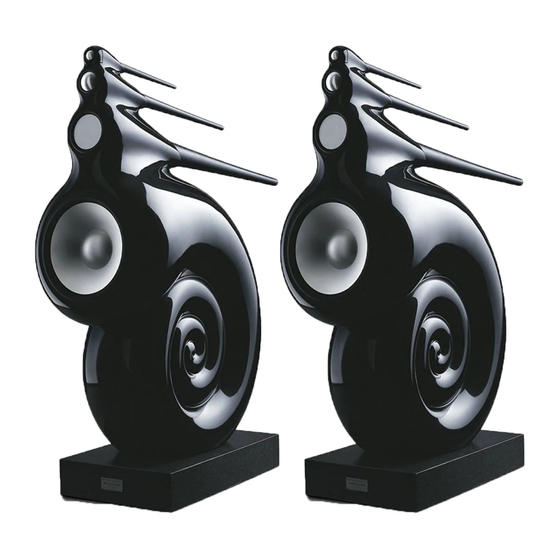
Table of Contents
Advertisement
Quick Links
Enclosure
Exponential line loading is used for all four
drive units, primarily to achieve freedom from
resonance and reflection, but also for the
damping effect on the fundamental resonance
in the low frequencies.
The two dome units are tightly coupled to
their respective wave guides via a hollow pole
magnet which causes minimal discontinuity to
the advancing wave front.
A hollow pole magnet is also to be found
behind the lower mid diaphragm supported by
a chassis which itself forms the first 50mm of
the wave guide. The tube to which this is
attached is shaped to smooth the transition
from the chassis.
The distinctive natural appearance of Nautilus
is derived from the best compromise of folding
a tapered tube to save space whilst maintaining
the highest curvature-to-width ratio. Traditionally,
folded pipes have involved many 180° bends
which have serious frequency dependent
transmission properties.
6
10mm thick Glass Reinforced Plastic (GRP) has
been used for the exterior surface which, when
coupled with the doubly curved shape, results
in an extremely stiff enclosure. The inner turns
of the spiral are bounded by a foam filled GRP
which braces the opposite faces of the snail in
a manner similar to the Matrix type enclosure
perfected by Bowers & Wilkins.
The external form of the Nautilus has been
achieved using a blend of hand-built forming
and advanced CAD technology borrowed from
the automotive industry. This enables Bowers &
Wilkins to maintain mathematical accuracy of the
wave guide and to produce the final mould tool
to submillimetric accuracy.
The high gloss surface finish is the result
of using a two-part acrylic paint with a deep
lacquer coat for lustre and durability. A 50kg
block of polished terrazzo type material supports
the complete mollusc.
Advertisement
Table of Contents

Summary of Contents for Bowers & Wilkins Prestige Nautilus
- Page 1 Enclosure Exponential line loading is used for all four 10mm thick Glass Reinforced Plastic (GRP) has drive units, primarily to achieve freedom from been used for the exterior surface which, when resonance and reflection, but also for the coupled with the doubly curved shape, results damping effect on the fundamental resonance in an extremely stiff enclosure.
-
Page 2: Drive Units
Drive units Crossover Each drive unit has been developed to The division of the signal into the four required operate as a piston within its intended bandwidths is accomplished in the Nautilus frequency band, with two octaves between Active Crossover via totally nonresonant the upper roll-off and the first sign of break- circuitry. - Page 3 Unpacking These notes will explain in depth how to Attention: Please carefully read through unpack the plinth and speakers. Inside this these instructions in full before starting crate is a copy of the Nautilus user manual to unpack the product. Unpacking should that will show how to connect the Nautilus be carried out by two people due to the loudspeaker system.
-
Page 5: Installation
Positioning Installation Placement of any loudspeaker can significantly All connections should be made with the realistic levels of reproduction. Most amplifiers influence the relative balance of sound in the equipment turned off. Each Nautilus comes capable of delivering 100 watts into 6 ohms listening seat and we recommend a degree of with its own dedicated active crossover network. -
Page 6: Cable Connection
Cable connection High Frequency Unit Connection to Nautilus is via an 8-core cable of high purity silver on copper, terminated in bare + RED + ROT + ROUGE + ROJO + ROSSO – BLACK – SCHWARZ – NOIR – NEGRO –... -
Page 7: Fine Tuning
Fine tuning After care Before fine tuning the installation, double check on the perceived sound quality by altering The GRP cabinets normally only require dusting. the polarity and security of the connections. the excitation of these modes. Try mounting If you wish to use an aerosol cleaner, spray onto If the hand-tightened nut that holds the the speakers along a different wall. -
Page 8: Specification
Specification Technical features Nautilus tube-loading active crossover Description 4-way tube-loaded loudspeaker system Drive units 1x ø300mm (12 in) aluminium cone bass 1x ø100mm (4 in) aluminium/polymer sandwich cone lower midrange 1x ø50mm (2 in) aluminium dome upper midrange 1x ø25mm (1 in) aluminium dome high-frequency Frequency range -6dB at 10Hz and 25kHz Frequency response...










